We received a lot of positive reaction to the roundtable discussion we hosted on how to launch your company without breaking the bank, as well as an accompanying launch playbook. Many founders and CEOs wanted a follow-up discussion about the next steps young companies should take in building out their marketing functions. In response to these requests, I hosted a discussion with Ranjeet Vidwans, an experienced executive and consultant who advises Norwest portfolio companies on product marketing.
Founders and CEOs from Norwest portfolio companies joined the conversation.
Following are highlights from the discussion, which focused on three topics:
1) Building your marketing foundations to prepare for launch
2) Starting your first demand generation activities after launch
3) Resourcing your team and budget
1. Building the Marketing Foundations to Prepare for Launch.
Renée: During our discussion about launching a company, we talked about the potential for disappointment when the initial rush of attention created by the launch dies away. This often leaves founders wondering, “What’s next? Where are the sales leads?” What can founders do to avoid this disappointment and continue building momentum? (7:40 on the recording)
Ranjeet: Preparing for your post-launch phase is as important as preparing for the launch itself, especially if the goal is to start driving inquiries, evaluation and eventually sales. Revenue generated from demand gen programs is ultimately the metric by which marketers are measured. But before you task someone with creating and executing demand generation programs, there are some foundational steps that are critical.
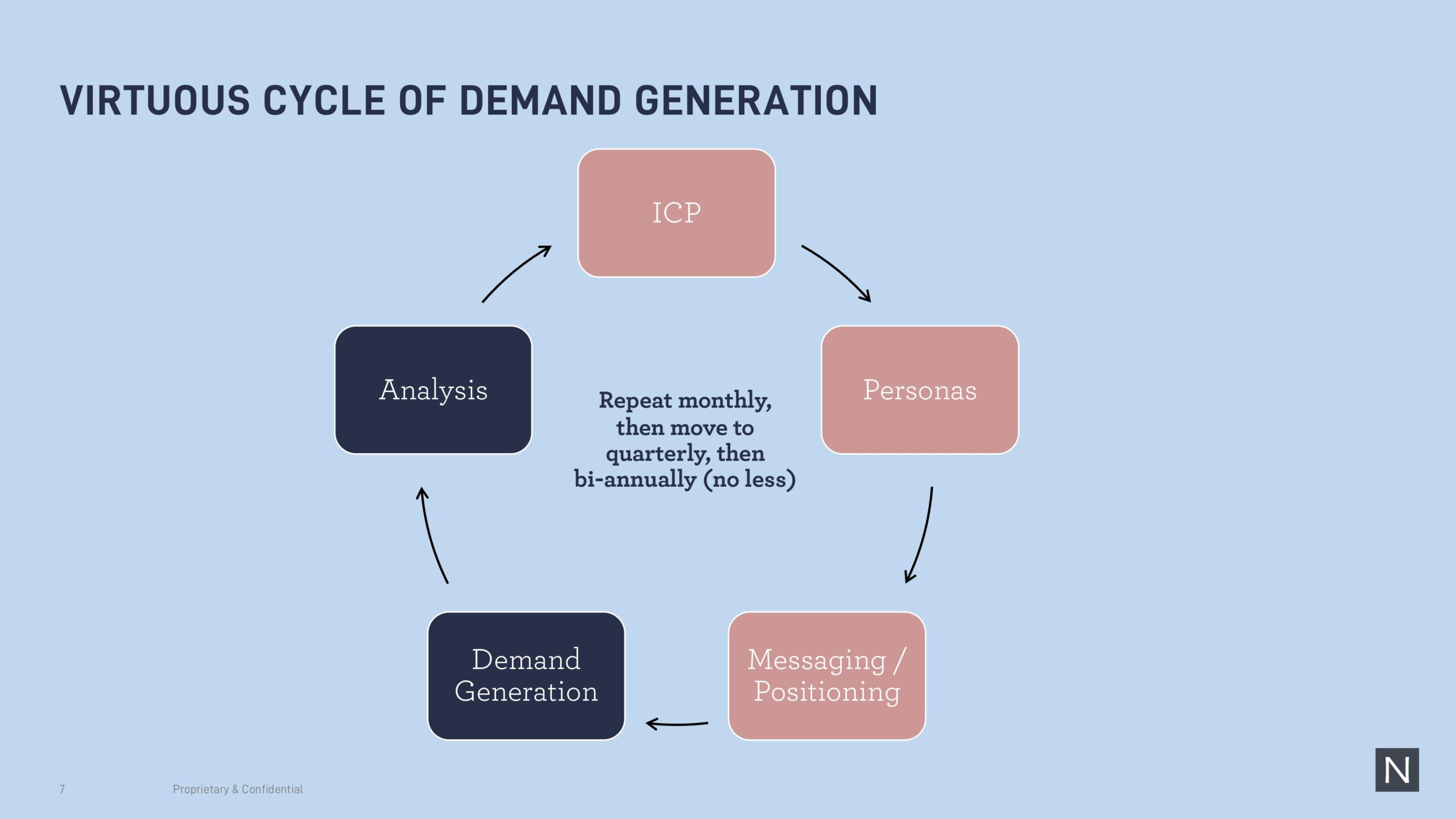
Before you do anything, you must define your ideal customer profile (ICP). We like to think of demand generation as part of a virtuous cycle with the ideal customer profile (ICP) as the crucial first step. Who are we targeting? That involves understanding the characteristics of those target customers. Moreover, the foundation of the messaging we send to those targets’ rests on a positioning platform. That’s the process of describing the pain points your target buyers are feeling and how we solve problems they face. You’ve got to have these elements in place before launching demand generation, so you’re targeting the right people with the right message to convince them of their need for your offerings. Once you launch your first programs, you must analyze the results and determine if you need to revisit or revise your ICP and messaging. It’s a dynamic, continuous cycle.
Most of us are familiar with at least the concept of an ideal customer profile—geography, industry, company size. But you need to go deeper than just those basics. If you’re selling security, for example, you want to know what identity-management tool they are using; what enterprise identity directory. If you’re selling learning and development solutions, you want to know how big the HR department is and whether there is a learning department. What software tools are already being used by the companies? Who are their customers?
Once you have the ICP defined, you then want to know the persona of who you want to talk to in that company. You may have two or three personas that are relevant—the economic buyer, end-users, and possibly influencers. For each of those, you want to understand what they’re trying to solve. What are their pain points? As a starting point, we use an excellent template from HubSpot:
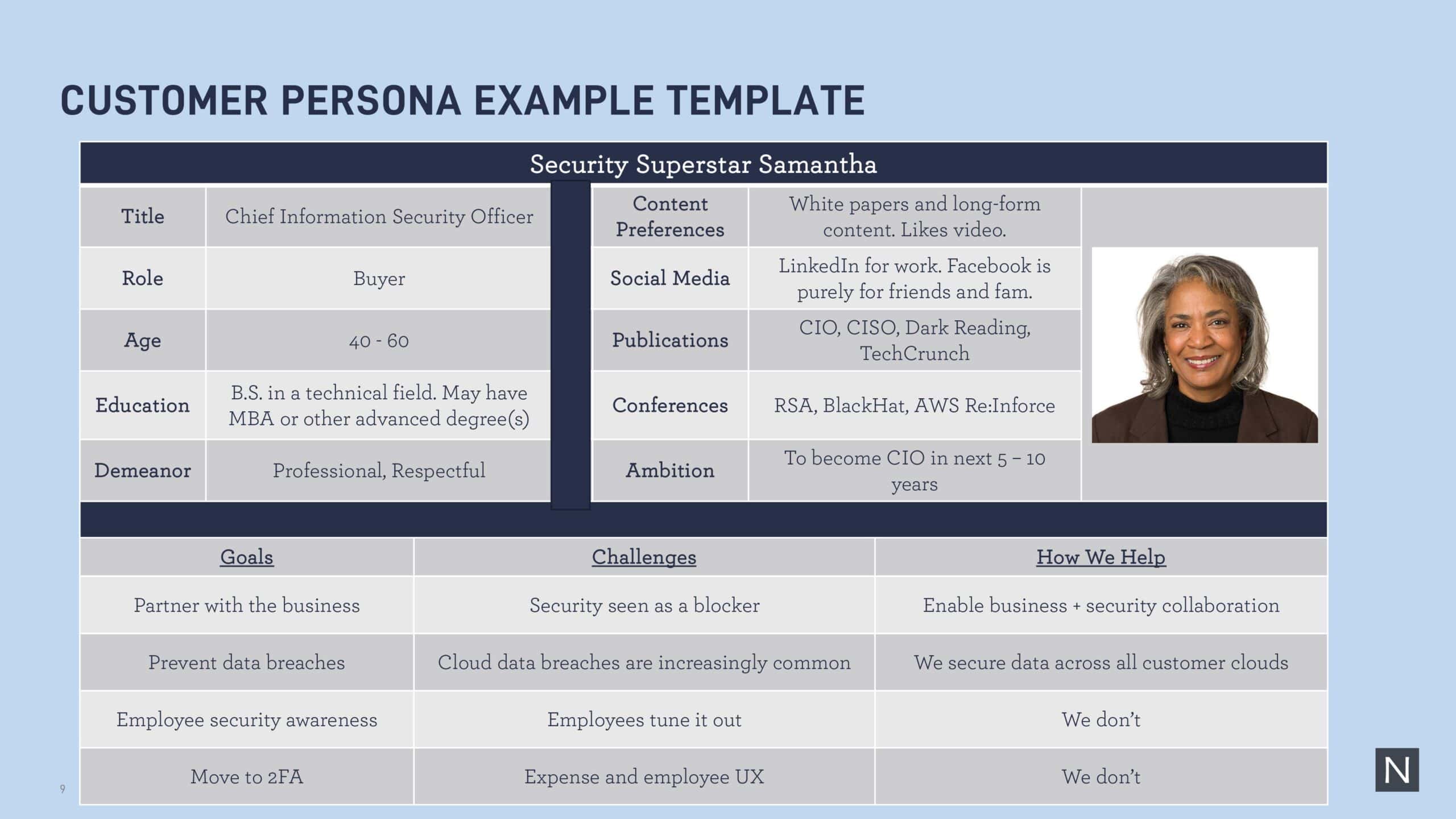
It’s not just their title and how large their team and budget are. It’s how they like to consume content. What conferences do they attend? What are their career objectives? How do they use social media? One common thing we hear is that LinkedIn is great for professional interaction, but Facebook is how they interact with friends and family.
You need to have clarity on what this person is responsible for and what part of their day-to-day job you help with. There are also several things this person cares about that you most likely cannot help them with. It’s important to know that because you get a better sense for how much of their mind share you can capture.
2. Starting Your First Demand Generation Activities After Launch.
Renée: To the point Ranjeet was just making, any PR expert will tell you it’s hard to pitch a story if you don’t have a clear message on your target market and buyer, the problem you’re solving for them, and your competitive differentiation. So now we want to call out some low-cost ways to start building awareness and credibility for your company, because you want to look bigger than you really are. (17:40)
Ranjeet: We want to break down some of the key pillars of awareness and demand gen. Where should you focus at this stage of your company? There are several levers you can pull on and most of these should be familiar.
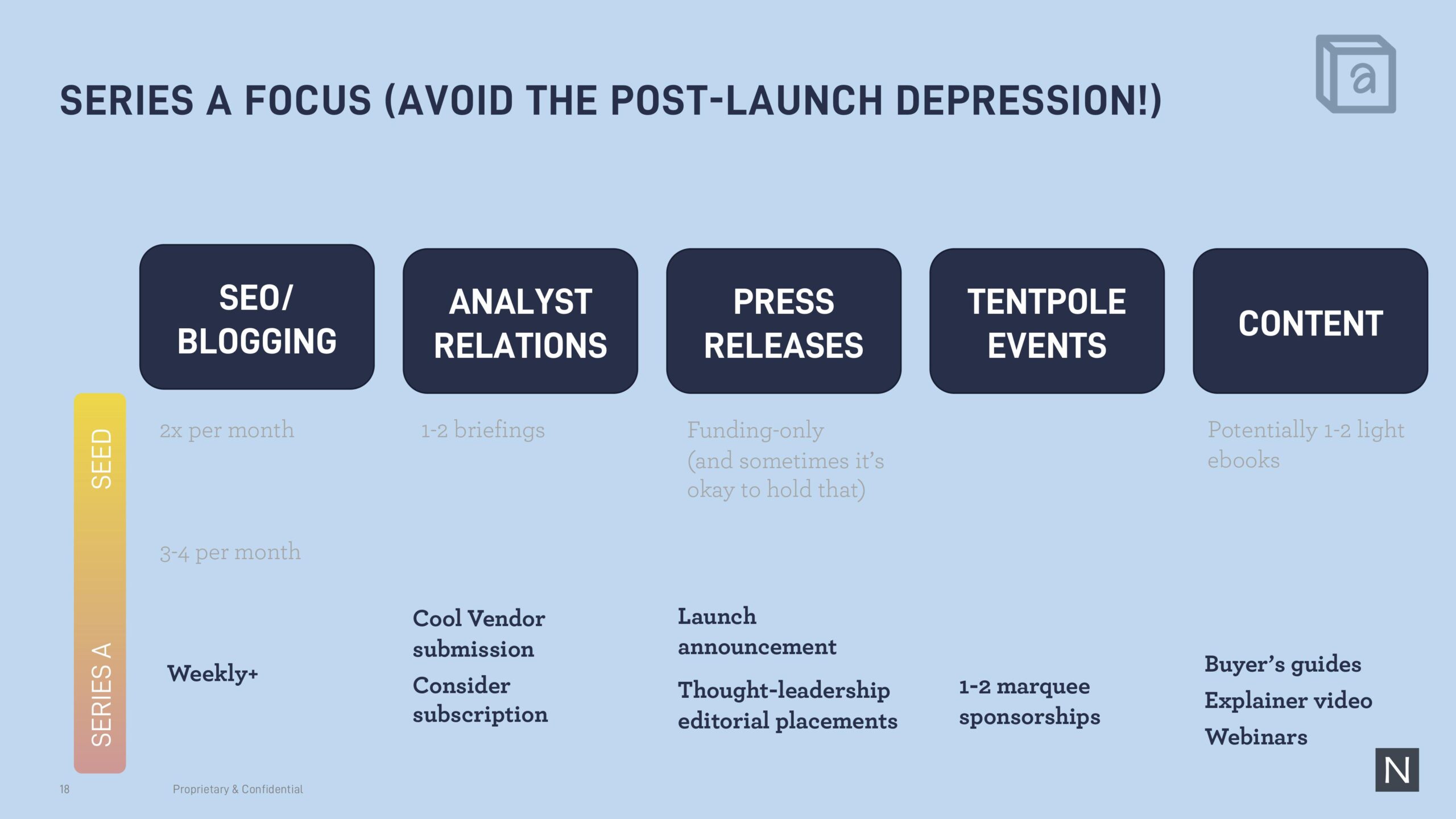
The one you control the most is your own SEO and content strategy—what you say on your website and blogs. Further on, you can reach out to industry analysts and to the press and invest more in events and complex content creation like videos and podcasts
All these can take up an inordinate amount of time and budget, so where does a seed or Series A company focus? At the seed stage, you want to focus on the left side. Make sure you are blogging; do all the organic things you can control. Go back to your ICP and target personas: write about their problems and pain points and how you help them solve them. As you progress from seed to Series A, you want to start ramping the frequency with which you blog, and possibly supplement it with outsourcing. This is what you should be focused on, not only because it raises awareness, but is a useful way to test your messaging. Did some topics resonate? Is there a particular phrase that’s driving traffic?
Even as a seed company, you may have some opportunities to start building relationships with the market analysts. Forrester and Gartner let non-client vendors brief them once or twice a year because they want to stay up on developments. And Gartner has its “Cool Vendor” program, which highlights new companies with innovative products or approaches. Later on, you may want to consider a subscription to some analysts. These are not cheap; they can run $50,000 to $100,000 a year. And if you buy a subscription, make sure you designate someone to work with those analysts. Allocate a quarter of someone’s time for regular analyst briefings and to see what they’re publishing and tweeting. Let them know what you’re doing so they can be best informed when briefing their corporate clients (your buyers).
When it comes to PR, you may have something important early on that you want to publicize – such as early customer wins or partnerships. If you have launched and have a generally available product, that’s newsworthy. You also can take some of the blogs you have written and turn them into contributed articles. At this stage, you may not have a formal editorial calendar, but you should have a roadmap of what might be happening in the next two quarters that may be opportunities to engage with press, analysts, and outlets for contributed articles.
And now’s the time to start thinking about marquee sponsorships for some of the bigger events in your target industry. Be aware, though, that these are not just hard-dollar expenses; they require a lot of effort for planning, staffing and execution.
Finally, you get into much richer, demand gen focused forms of content—a regular webinar, for instance, or an animated explainer video or a podcast series.
3. Resourcing Your Team and Budget
Renée: Let’s talk about who’s going to do all this work and what it will cost. (27:00)
Ranjeet: We know that each company is going to be a little bit different. So, this is going to be general guidance.
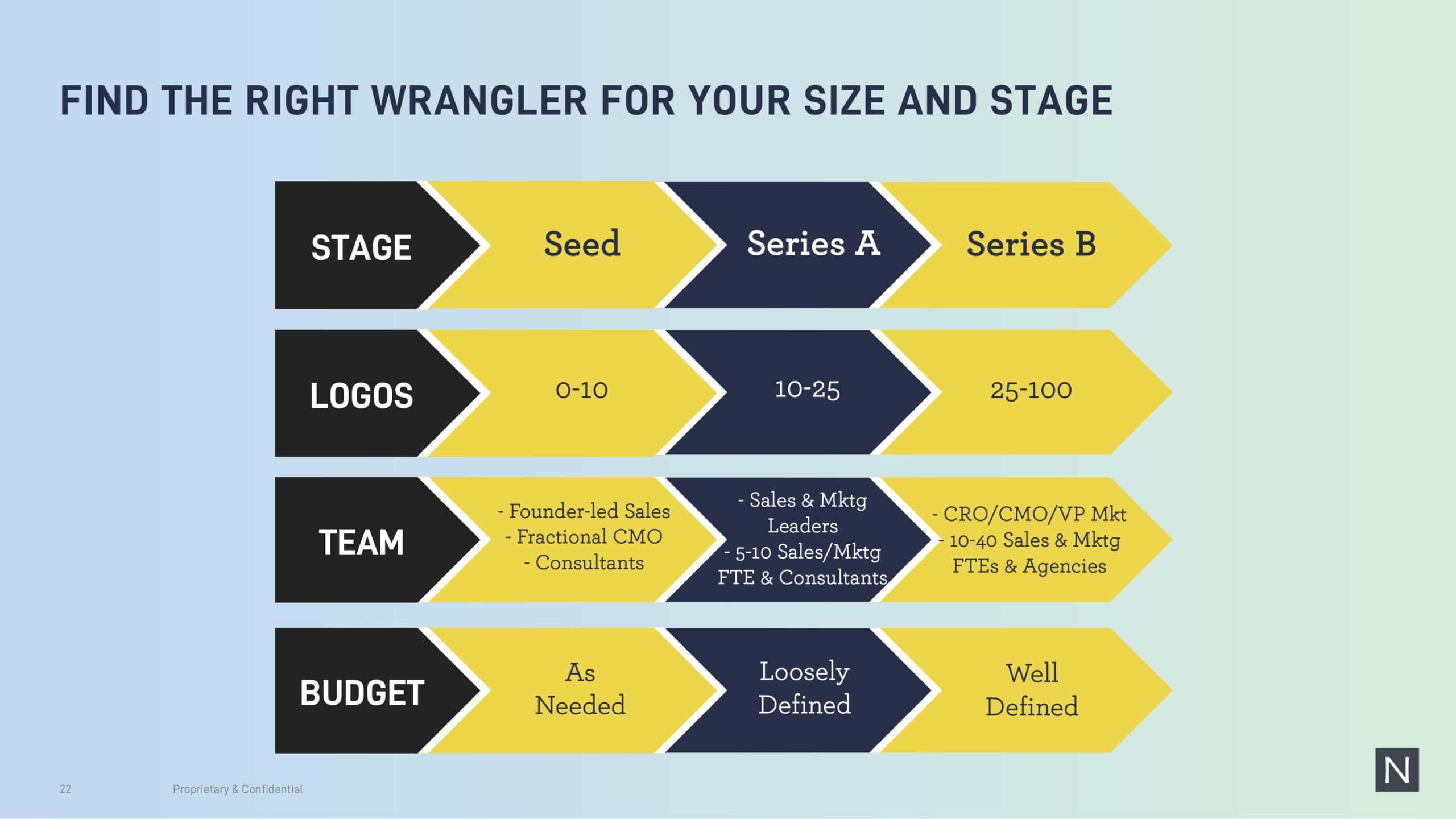
At seed stage, you either have no customers or you have a handful of early adopters, your first few customers (logos). It’s mostly or exclusively founder-led selling and on the marketing side what you typically want is a fractional CMO—someone with seniority and expertise that won’t take a big chunk of budget. This person will help you pick the right combination of contractors or small agencies to do the work. Budget, at this stage, is as-needed.
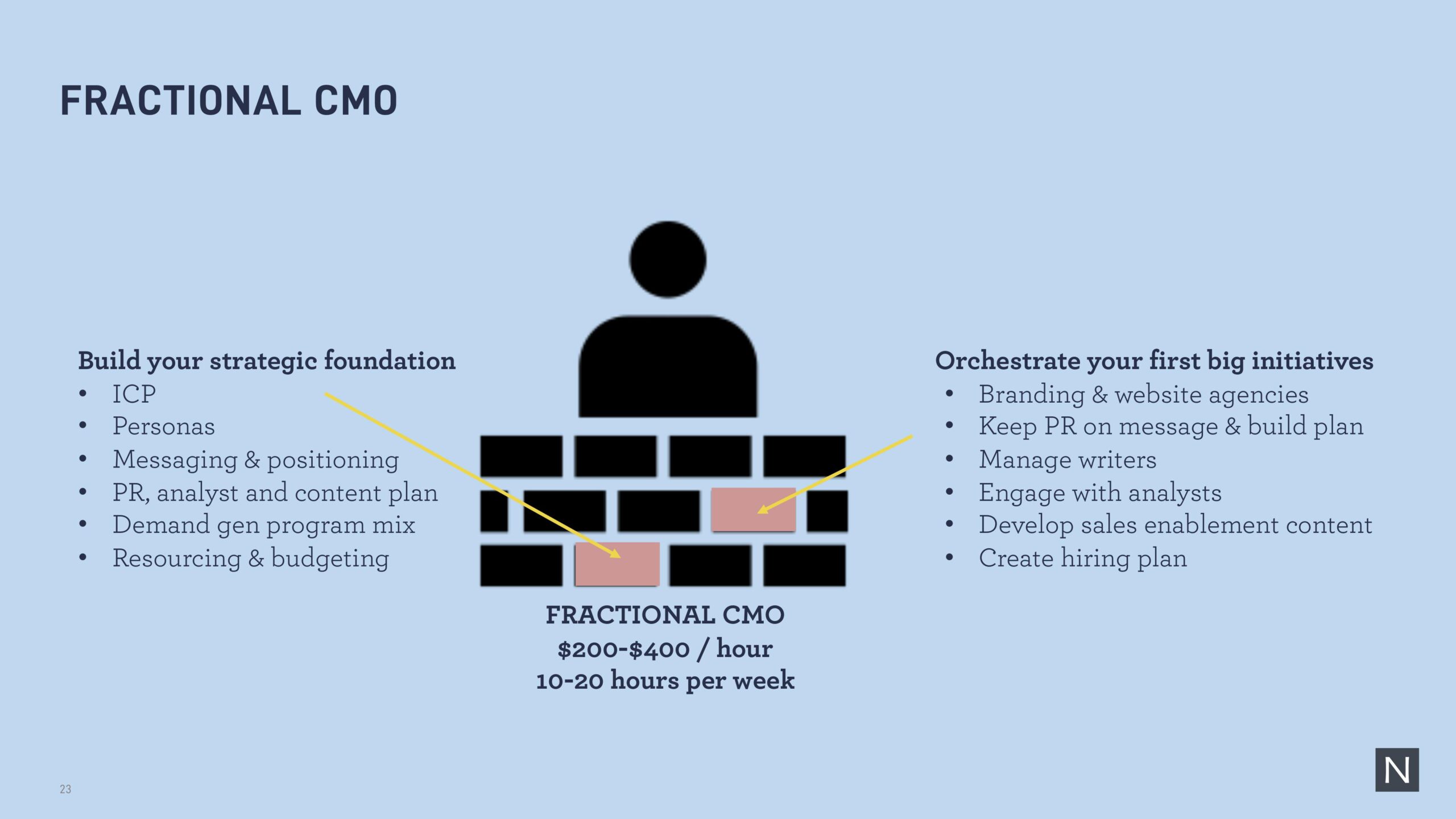
A fractional CMO is useful to get experienced help but on a pay-as-you-go basis depending on what you need. The fractional CMO will help with a lot of the things we talked about at the beginning: determining the ICP, target personas, and your messaging platform; putting together a plan and budget; finding outside resources to do the work; helping you with those early analyst pitches; things of this nature.
As you progress to Series A, you have more than a handful of customer logos. You’re building some repeatability and starting to scale. At this point, you should have both sales and marketing leaders. They will not be “C” executives; they may be VPs or even directors punching above their weight. They will be FTEs who have teams under them that are a combination of FTEs and contractors or consultants. Depending on what you’re selling, you may have sales engineers. You should have your arms around a budget, but it will be loosely defined.
As you mature to Series B, you’ve got repeatability. You’ve got some data that can help you predict what sales and marketing resources you need to hit your revenue targets. At this point, you have VP-level, if not C-level leaders for sales and marketing. You may still have agencies but now you’re using them for expertise and scale, not just as staff augmentation. And you have a well-defined marketing budget.
Renée: A question we often get is, how much should I be budgeting for marketing? (34:00)
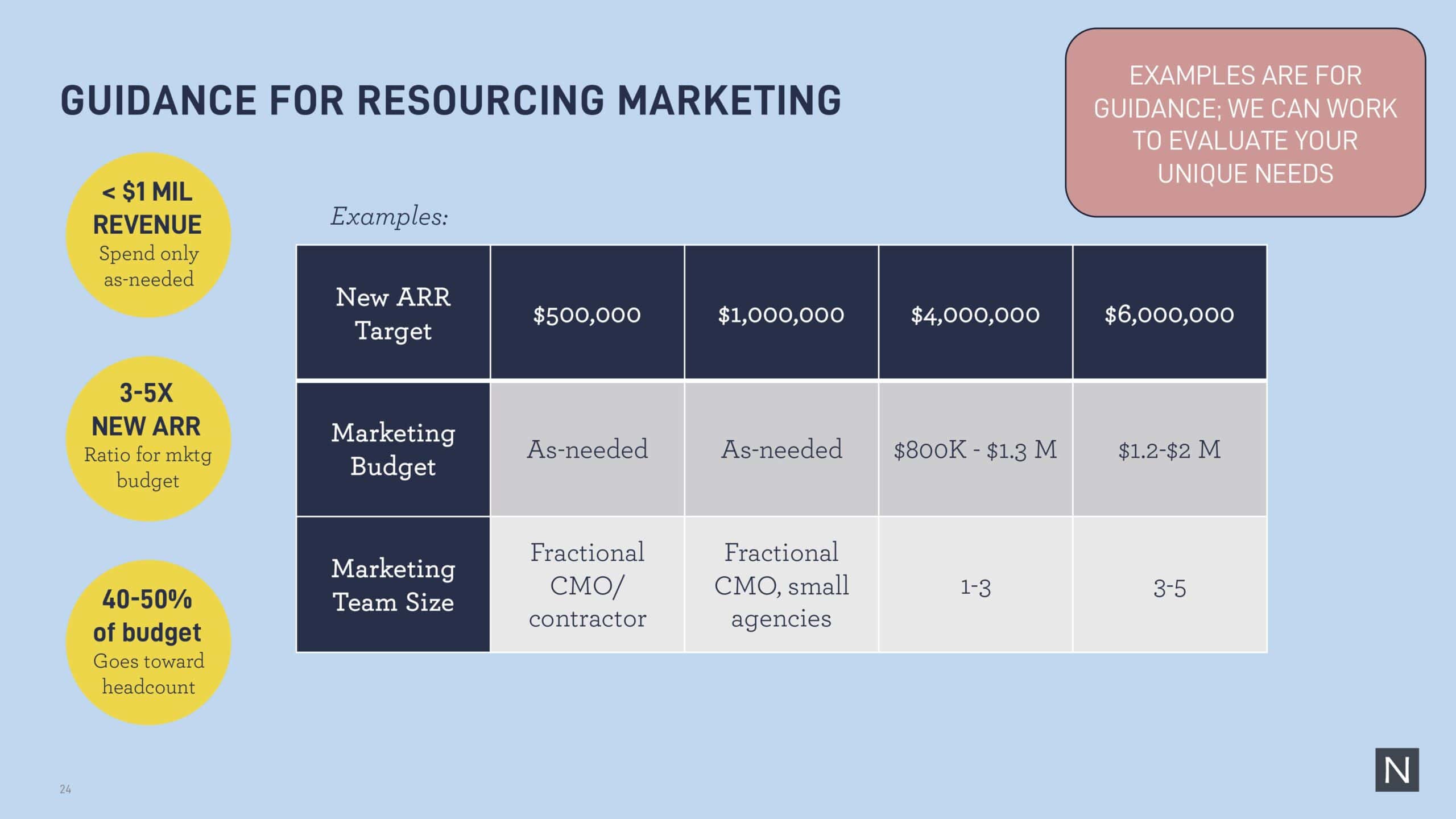
What we’re presenting here is not necessarily meant to be prescriptive but are numbers we tend to see for companies at seed or Series A stage. Under a million in revenue, perhaps even up to $2 million, it’s going to be as needed. Think about what you need for your launch and for activities to keep that momentum going. Once you are beyond $2 million and start firming up annual revenue targets, we tend to see a ratio of revenue to marketing budget is your new ARR target is about 3x to 5x your marketing budget, with about 40 to 50 percent of that going for headcount. (For example, if your new ARR target is $10 million for the coming year, the total marketing budget is about $2-3.3 million.)
As you grow, you may have an aggressive revenue target for the next year, but our advice is to not unlock all that budget right away. Instead, unlock a little bit, see what’s working, and then have the confidence to move forward. Think about how you want to break up your budget quarter to quarter and what milestones you want to hit along the way.
We often are asked what’s a good return on ad spend for B2B SaaS companies. I always have to say it depends, and we can talk about your specific sales cycle. For example, the return on ad spend is going to be different for a self-service product (where a ratio of 2:1 to 3:1 is where you want to be) versus a longer enterprise sale, where it’s going to be more of a blended ROI because it’s not a direct-response type of digital program. You’re pulling people through the funnel.
Ultimately, the goal is to tie marketing activity back to revenue creation. But it takes time to determine hard KPIs, so you must look at some leading indicators. Is your branded search traffic increasing over time? Are you seeing more visitors to your site, and can you analyze the traffic to understand if you are targeting the right people. How do you know the message is resonating?
The thing I want to highlight is the need to look at the ICP and target personas you developed and see if you are engaging with those accounts. Maybe they have clicked on an email or downloaded a piece of content. Or you can track accounts that are engaging with your LinkedIn ads. These are some of the KPIs I would pay attention to, at least as leading indicators, to see if you are on the right track of moving activity along the funnel and eventually into revenue.
Key Takeaways
Renée: Ranjeet, can you wrap up with some of the key takeaways from today’s session? (43:10)
Ranjeet: Here are three key takeaways.
1) The virtuous cycle we presented at the beginning is so important. Before anything else, understand who you’re targeting, how you’re improving their life, what they care about. Why should they trust you and what are your proof points? Doing so will require time and it’s a lot harder than you think it’s going to be. But when you do, it will give you much greater leverage on the things you spend hard dollars on later.
2) Know who you’re talking to. Understand what their life looks like with and without you and without your competitors. What keeps them up at night? Where do they see themselves in five years? What are their career ambitions? How can you help them solve bigger problems that will give them a win in their organization and help them get where they want to go? This should come through in the content you create and the blogs you write, even in the way your sales pitch decks and demos work.
3) Write two articles a month. Start this well before your first launch or funding announcement. This is a way to crystallize your own thoughts: here’s the problem I’m solving; here’s why my approach is different; here’s how this could revolutionize things that matter to my target persona. I am a big proponent on writing one’s own blog, then syndicating it. Do a digest version of it for LinkedIn, or a month later repost it somewhere with appropriate backlinks so you don’t get dinged by Google. This starts building your SEO authority and is a great way to test your message. You can see what’s resonating and where you got more visits and more engagement.




